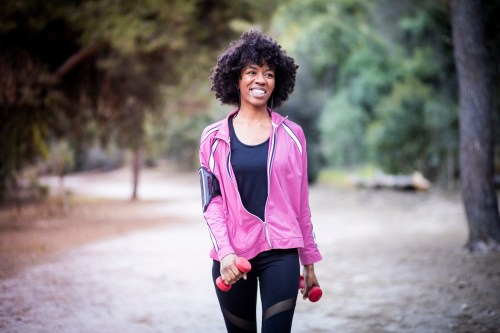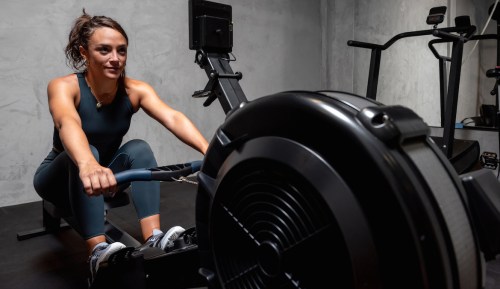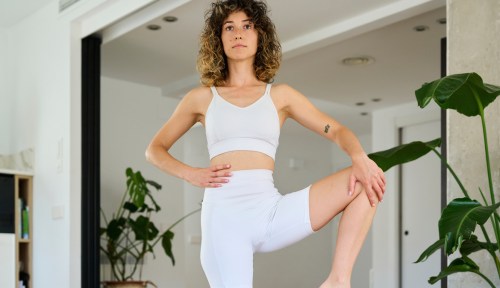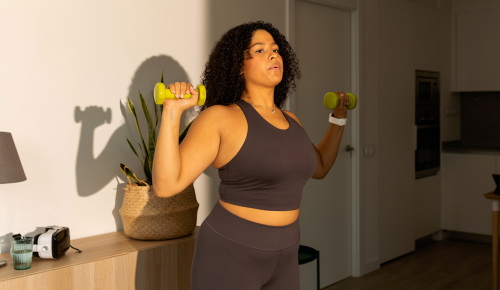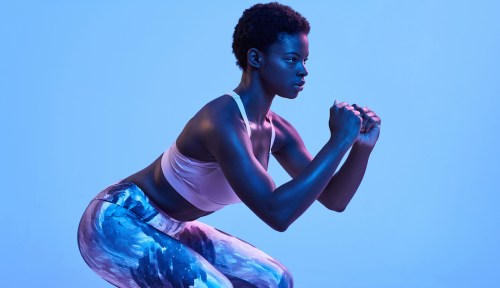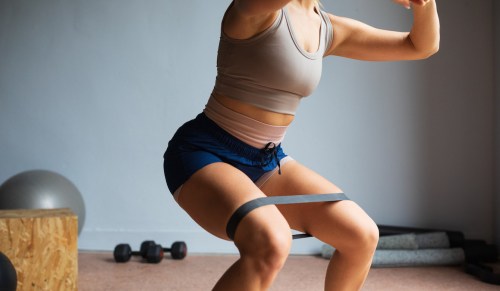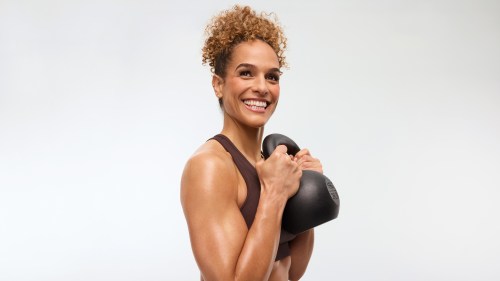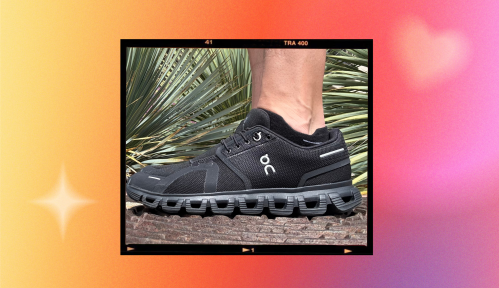Our editors independently select these products. Making a purchase through our links may earn Well+Good a commission
Walking is finally getting recognized as an adequate form of exercise. It’s a great way to increase your heart rate and work up a sweat, all while getting some much-needed fresh air in the process. There are many sweat-inducing upgrades to incorporate into a walk around the block or a solo stroll on your treadmill. A popular option? Exercises for arms.
Experts in This Article
certified personal trainer and creator of BodyFit by Amy
Andrea Speir is a pilates instructor and the founder of Speir Pilates.
head trainer at P.volve
“By adding an upper-body element, you’re setting the intention of the walk as a full-body workout,” says Andrea Speir, founder of Speir Pilates. “Intuitively your pace picks up, your core and postural muscles engage, and your health results are improved and heightened.”
Intrigued? Keep reading to uncover the benefits of walking with weights, power walking techniques, how to turn your treadmill strut into a full-body workout walk, and more.
First things first: The benefits of walking with weights
It’s simple. According to NYC-based Barry’s instructor Izzi Lynn, performing arm exercises while walking “will require you to engage your core, something we may not be doing when on a regular, leisurely walk so the benefits span from head to toe,” she says.
What is proper walking posture?
One of the challenges that walking poses is posture. When you’re walking and your arms are swinging to your sides, it’s possible to round your shoulders forward with a slouched posture, she adds, which is not that ideal.
The best walking posture, according to the Mayo Clinic, is to have your head looking forward, your spine straight (not arched back or forward), your arms moving naturally, and your shoulders back.
Adding exercises for arms to the mix can help make obtaining proper walking posture that much easier. “The shoulders, lats, and traps drawback, helping you to move from a place of proper postural alignment, and it can promote increased strength in your arm muscles over time,” Speir says.
What size weights should I use for arm exercises while walking?
Ahead you’ll find a variety of the best exercises to do while walking. “These exercises can be done with no weight at all, but you can also hold a light set of weights or strap on some wrist weights to increase the intensity of the movements,” says Maeve McEwen, a senior trainer for P.volve.
When selecting weights, you’ll want to stick to no more than five pounds, and ideally just one to two pounds. “Since you’ll be walking, heavier weights could compromise form or put pressure on your back,” says Amy Schemper, CPT, certified personal trainer and creator of BodyFit by Amy. “Keeping it lighter allows you to keep moving during your walk, with a little extra burn for your arms.”
No weights on hand? We love the ever-chic Bala Bangles ($65)—as do many fitness instructors. “I am partial to something around the wrists because you can stay hands-free,” Lynn says. “Something light is key, you don’t want to get overly tired and have to haul home heavier weights, plus we want to keep your upper body somewhat relaxed so your walking pace doesn’t suffer.”
All in all, arm weights for walking are great for anyone who wants a lighter entry point to strength training or finds doing one specific exercise at a time kind of boring. And if you don’t have any dumbbells or light wrist weights, there’s always the option to use resistance bands. “A resistance band is an easy prop to bring along and stick in your fanny pack/waistband when not in use,” Lynn says.
Ready to get started? Try these trainer-approved arm exercises while walking on your next stroll for an even more effective workout.
“The best fitness is fun and I think adding in some upper body to a walk, especially with friends, is a great way to channel our inner Jane Fonda—we all have one!—and try something new.” —Izzi Lynn, Barry’s instructor
The best arm exercises to do while walking
1. Pumping arms (aka runner’s arms)
Muscles worked:shoulders, core, back, and chest
Pumping your arms aggressively may feel more comedic than effective but Lynn and Schemper assure us that doing so can take your walk to the next level.
“Keeping arms bent and palms facing in, pump your arms forward and back as you walk, similar to the arm movement during running,” Schemper says. “Keep the core engaged, and chest open and lifted for good posture. This works your arms and back, and adds intensity to your walk.”
How to do it:
- 1.Begin with your arms by your side.
- 2.As you start walking, pump your arms in sync with your legs, moving your opposite arm and leg forward at the same time.
- 3.Really pump those arms—don’t just let them swing forward. “Think about driving the elbow back and sweeping the side of your body,” Lynn instructs.
TIP
To amp up this movement, add wrist weights or light dumbbells to the mix.
2. Biceps curls
Muscles worked:biceps, shoulders, lats, and traps
“This movement imitates a bicep curl you might traditionally do in a fitness class or at the gym, so it’s something super intuitive to do while you’re moving your lower body and getting the heart rate up,” Speir says. “It reminds you to keep the shoulders pulled back and down, and the core engaged, which is so helpful when walking. Even if you’re doing this without any added weight, the action will strengthen and tone the biceps, shoulders, lats, and traps.”
Additionally, it’s important to remember that a strength training move can be beneficial without feeling like the hardest, heaviest move ever. This is a great example of that.
How to do it:
- 1.Begin with your arms straight in front of the thighs, palms facing away from your body.
- 2.Bend the elbows, bringing your hands up toward your chest.
- 3.Extend your arms and lower them back down.
Upgrade your bicep curls with this “bicep curl + press out” variation:
3. Lateral raises
Muscles worked: shoulders and upper back
Looking for a simple arm exercise that won’t majorly distract you from your stride? Lynn suggests opting for lateral raises. All you have to do is lift your arms up and down with care while moving forward in your walk.
How to do it:
- 1.Begin with palms facing into your thighs, with light weights or wrist weights for added resistance
- 2.Squeeze your shoulder blades together and raise your arms to shoulder height.
- 3.Lower down with control.
- 4.Repeat
4. Straight arm shoulder circles
Muscles worked: deltoids, rotator cuff, and upper back muscles
“This exercise will help increase mobility in the shoulder joint, helping open up your posture for better alignment in your stride,” McEwen says. It’s a great second step in a walking arm workout after you get some blood flowing from a warm-up walk and the biceps curls.
How to do it:
- 1.With straight arms, gently and slowly circle your arms in both directions, only to where you can keep your core engaged, chest open, and shoulders down.
- 2.Inhale as you reach up and exhale as you lower your arms, working to initiate the movement from your back.
5. Bodyweight shoulder rolls
Muscles worked: deltoids, rotator cuff, and upper back muscles
Incorporating exercise for arms into your walking routine doesn’t have to be complicated. It can be as simple as working bodyweight shoulder rolls into your stroll, according to Schemper.
“Let’s face it, many of us suffer from tight upper back and rounded shoulders due to the time we spend at our computers, looking at our phones, driving, and beyond,” she says. “Gently rolling the shoulders up, back, and forward will help release some of that tension, and strengthen your shoulder joints and muscles.”
How to do it:
- 1.Start with your arms by your side.
- 2.Slowly shrug your shoulders up, back, and down.
- 3.Repeat.
6. 90-degree arm swings
Muscles worked: shoulders, arms, chest, and upper back
“This exercise works the entire arm, helping build strength and tone,” Speir says. “It’s also fantastic to elevate the heart rate and make your walk that much more effective for your entire body. The swinging action of the arm actually helps motivate your entire body to keep a brisk pace, helping to improve cardiovascular health.”
How to do it:
- 1.Begin with your arms bent into 90-degree angles, palms facing toward each other.
- 2.Lower one arm down toward the rib cage.
- 3.Begin alternating your arms (one high, one low) at a brisk pace.
- 4.Aim to keep this action as large as you can go without your shoulders rising up toward the ears, and at a pace that is challenging, but that you can maintain.
7. Uppercut to goal post squeezes
Muscles worked:shoulders, chest, and back
“This move strengthens and stretches your shoulders, chest, and back, which will improve your posture,” McEwen says. When your posture rounds forward as a result of sitting at a desk or a larger chest, your neck, back, and shoulder muscles can often take on more strain, according to the Mayo Clinic.
This move can help stretch out tight chest muscles, and relieve tension in your back, neck, and shoulders—in addition to strengthening those areas as well.
How to do it:
- 1.Start with your arms at a 90-degree angle framing your face while squeezing your biceps and fists.
- 2.As you walk, squeeze between your shoulder blades to open your arms to a goal post position, then return to the starting position, squeezing from your chest.
8. Cross-body punches
Muscles worked: obliques, shoulders, and back
Uppercuts aren’t the only boxing-inspired exercise for arms that can be paired with walking. Lynn and Schemper suggest cross-body punches, too.
“If you’ve ever taken a kickboxing class, you know, punches get your heart rate up and your arms and back working hard,” Schemper says. “You’ll likely find a good rhythm with your walking pace, and feel the arm burn and cardio boost.”
As with most arm exercises while walking, it’s best to do them one arm at a time with your moving arm working in tandem with your forward-stepping leg.
How to do it:
- 1.Establish your walking pace.
- 2.Make a fist and punch across the body without letting your hips rotate.
- 3.Repeat with each step.
9. Swimming row
Muscles worked: shoulders, chest, lats, biceps, and triceps
“This action imitates a breast stroke-style swimming motion, allowing you to get a gentle hit of circulation into the upper body while toning and elongating the upper body muscles,” Speir says. “It constantly changes the angle of the arm movement, which challenges and tones not just the arms, but the postural muscles and shoulders as well.”
How to do it:
- 1.Begin with your hands together above your sternum.
- 2.Reach your arms forward to straight arms.
- 3.Reach your arms wide to the side.
- 4.Bend your elbows and bring your hands together back above your sternum.
This workout is designed for runners, but you can the format for a walking workout, too:
The takeaway
Going for a walk can be a great way to unwind or rev up your engine for a killer day. Doing some of these arm exercises while walking, if you’re looking to add some more flavor to your walking workout, can have a big impact on your cardiovascular health and upper-body strength over time.
“Over time, these movement patterns will help build mobility and strength in your shoulders, lats, upper back, biceps, and core,” Lynn says. “While it might not be as visibly noticeable as, say, doing an upper body workout at the gym, you will see increased endurance as well as an improvement in posture.”
The beauty of incorporating arm toning exercises into your walking routine is that they’re virtually impossible to overdo.
“When the mood strikes to incorporate some upper body, aim to complete three sets of 12 reps of each move,” Lynn recommends. “You will definitely feel the burn!”
If you opt to perform these exercises equipment-free, Lynn suggests slowing down each movement for optimal benefits. “Increased time under tension is a great way to up the challenge of any move (with or without weights),” she explains.
Most importantly, have fun with it! “The best fitness is fun and I think adding in some upper body to a walk, especially with friends, is a great way to channel our inner Jane Fonda—we all have one!—and try something new,” Lynn says.
FAQ
How can I work out my arms while walking?
The easiest option is to use wrist weights, like Bala Bangles, because they’re hands free. But you can also hold one- to two-pound weights in your hands. (Going any heavier than five-pound weights may compromise your walking form or put pressure on your back, which could lead to discomfort and even injury.
What are some effective arm exercises to do while walking?
You can do biceps curls, lateral raises, shoulder circles, shoulder rolls, and more with your hand weights while walking. We detail exactly how to do those moves—and more— above!
How often should I incorporate arm exercises into my walking routine?
You should incorporate resistance training into your routine two or more days a week, according to the Centers for Disease Control and Prevention (CDC). This includes working your arm muscles. However, it’s important to take time for your muscles to recover in between bouts of exercise. According to the American Council on Exercise (ACE), this timeframe can be anywhere from 24 to 72 hours, depending on how intense your workout was.
Sign Up for Our Daily Newsletter
Get all the latest in wellness, trends, food, fitness, beauty, and more delivered right to your inbox.
Got it, you've been added to our email list.
